SsangYong Korando vs VW Tayron – Which model is better for everyday use?
Both models have their strengths – but which one suits you more?
Compare performance, efficiency, price and space directly: SsangYong Korando or VW Tayron?
Here’s where it gets real: The technical differences in detail
Costs and Efficiency: Price and efficiency are key factors when choosing a car – and this is often where the real differences emerge.
SsangYong Korando has a decisively advantage in terms of price – it starts at 27000 £, while the VW Tayron costs 39000 £. That’s a price difference of around 11987 £.
Fuel consumption also shows a difference: the VW Tayron manages with 0.40 L and is therefore significantly more efficient than the SsangYong Korando with 7.50 L. The difference is about 7.10 L per 100 km.
As for range, the SsangYong Korando performs convincingly better – achieving up to 339 km, about 213 km more than the VW Tayron.
Engine and Performance: Under the bonnet, it becomes clear which model is tuned for sportiness and which one takes the lead when you hit the accelerator.
When it comes to engine power, the VW Tayron has a clearly perceptible edge – offering 272 HP compared to 190 HP. That’s roughly 82 HP more horsepower.
In acceleration from 0 to 100 km/h, the VW Tayron is distinct quicker – completing the sprint in 6.10 s, while the SsangYong Korando takes 8.40 s. That’s about 2.30 s faster.
In terms of top speed, the VW Tayron performs evident better – reaching 240 km/h, while the SsangYong Korando tops out at 191 km/h. The difference is around 49 km/h.
There’s also a difference in torque: the VW Tayron pulls minimal stronger with 400 Nm compared to 360 Nm. That’s about 40 Nm difference.
Space and Everyday Use: Beyond pure performance, interior space and usability matter most in daily life. This is where you see which car is more practical and versatile.
Both vehicles offer seating for 5 people.
In curb weight, the SsangYong Korando is to a small extent lighter – 1517 kg compared to 1682 kg. The difference is around 165 kg.
In terms of boot space, the VW Tayron offers evident more room – 885 L compared to 551 L. That’s a difference of about 334 L.
In maximum load capacity, the VW Tayron performs decisively better – up to 2090 L, which is about 842 L more than the SsangYong Korando.
When it comes to payload, VW Tayron slightly takes the win – 566 kg compared to 463 kg. That’s a difference of about 103 kg.
All in all, the VW Tayron shows itself to be leaves the rival little chance and secures the title of DriveDuel Champion.
It impresses with the more balanced overall package and proves to be the more versatile companion for everyday use.
SsangYong Korando
The SsangYong Korando offers a blend of contemporary design and practicality, making it an appealing choice for urban adventurers. Its spacious interior and comfortable seating ensure a pleasant driving experience for both driver and passengers. With its reliable performance and advanced features, the Korando stands out in the competitive SUV market.
details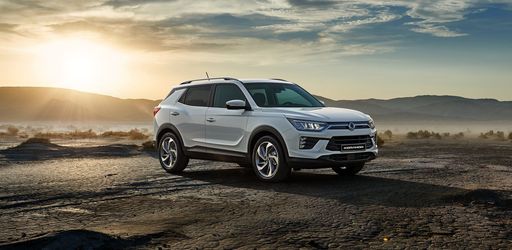 @ Ssangyong
@ Ssangyong
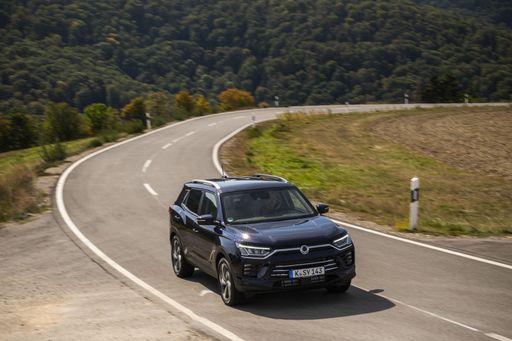 @ Ssangyong
@ Ssangyong
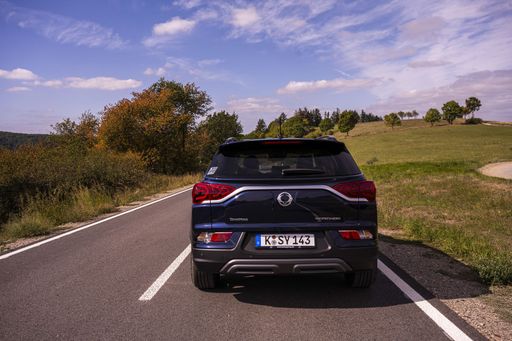 @ Ssangyong
@ Ssangyong
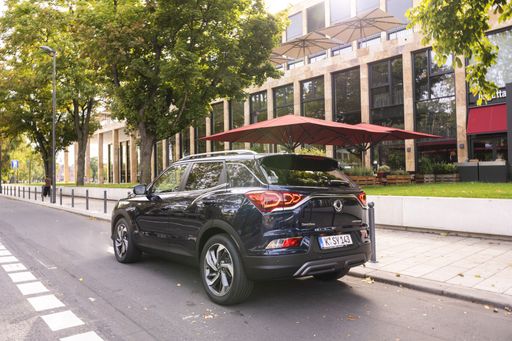 @ Ssangyong
@ Ssangyong
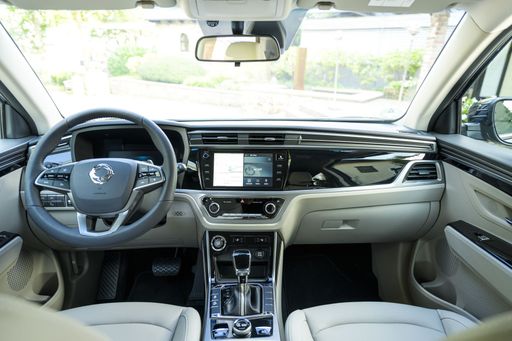 @ Ssangyong
@ Ssangyong
VW Tayron
The Tayron stands out as a stylish and versatile SUV that expertly blends form and function. With its spacious interior and modern design, it caters to families and adventure seekers alike, making every journey enjoyable. Equipped with advanced technology and safety features, the Tayron promises a driving experience that is both secure and exhilarating.
details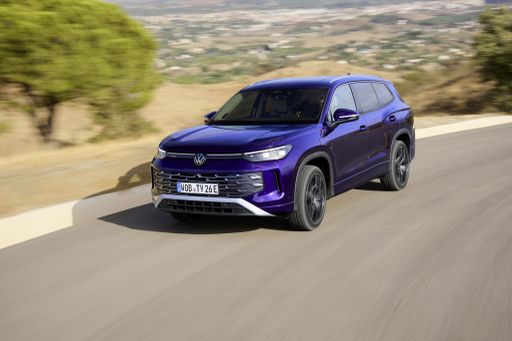 @ volkswagen-newsroom.com
@ volkswagen-newsroom.com
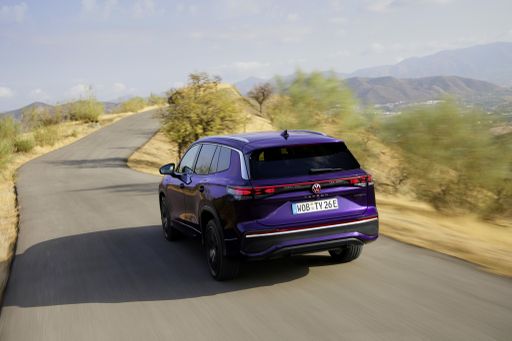 @ volkswagen-newsroom.com
@ volkswagen-newsroom.com
 @ volkswagen-newsroom.com
@ volkswagen-newsroom.com
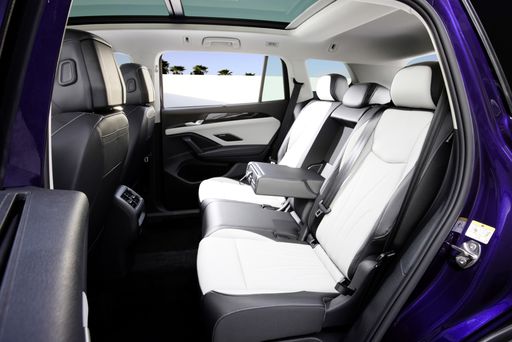 @ volkswagen-newsroom.com
@ volkswagen-newsroom.com

|

|
|
|
|
Costs and Consumption |
|
|---|---|
|
Price
27000 - 42000 £
|
Price
39000 - 52600 £
|
|
Consumption L/100km
7.5 - 8.6 L
|
Consumption L/100km
0.4 - 8.5 L
|
|
Consumption kWh/100km
16.80 kWh
|
Consumption kWh/100km
-
|
|
Electric Range
339 km
|
Electric Range
117 - 126 km
|
|
Battery Capacity
-
|
Battery Capacity
19.70 kWh
|
|
co2
0 - 197 g/km
|
co2
9 - 192 g/km
|
|
Fuel tank capacity
50 L
|
Fuel tank capacity
45 - 58 L
|
Dimensions and Body |
|
|---|---|
|
Body Type
SUV
|
Body Type
SUV
|
|
Seats
5
|
Seats
5
|
|
Doors
5
|
Doors
5
|
|
Curb weight
1517 - 1840 kg
|
Curb weight
1682 - 1948 kg
|
|
Trunk capacity
551 L
|
Trunk capacity
705 - 885 L
|
|
Length
4450 - 4465 mm
|
Length
4792 mm
|
|
Width
1870 mm
|
Width
1853 - 1866 mm
|
|
Height
1620 - 1645 mm
|
Height
1666 - 1668 mm
|
|
Max trunk capacity
1248 L
|
Max trunk capacity
1915 - 2090 L
|
|
Payload
410 - 463 kg
|
Payload
489 - 566 kg
|
Engine and Performance |
|
|---|---|
|
Engine Type
Petrol, Electric
|
Engine Type
Petrol MHEV, Plugin Hybrid, Diesel, Petrol
|
|
Transmission
Manuel, Automatic
|
Transmission
Automatic
|
|
Transmission Detail
Manual Gearbox, Automatic Gearbox, Reduction Gearbox
|
Transmission Detail
Dual-Clutch Automatic
|
|
Drive Type
Front-Wheel Drive, All-Wheel Drive
|
Drive Type
Front-Wheel Drive, All-Wheel Drive
|
|
Power HP
163 - 190 HP
|
Power HP
150 - 272 HP
|
|
Acceleration 0-100km/h
8.40 s
|
Acceleration 0-100km/h
6.1 - 9.7 s
|
|
Max Speed
156 - 191 km/h
|
Max Speed
204 - 240 km/h
|
|
Torque
260 - 360 Nm
|
Torque
250 - 400 Nm
|
|
Number of Cylinders
4
|
Number of Cylinders
4
|
|
Power kW
120 - 140 kW
|
Power kW
110 - 200 kW
|
|
Engine capacity
1497 cm3
|
Engine capacity
1498 - 1984 cm3
|
General |
|
|---|---|
|
Model Year
2021 - 2023
|
Model Year
2025
|
|
CO2 Efficiency Class
F, G, A
|
CO2 Efficiency Class
E, B, F, G
|
|
Brand
SsangYong
|
Brand
VW
|
What drive types are available for the SsangYong Korando?
Available configurations include Front-Wheel Drive or All-Wheel Drive.
The prices and data displayed are estimates based on German list prices and may vary by country. This information is not legally binding.
